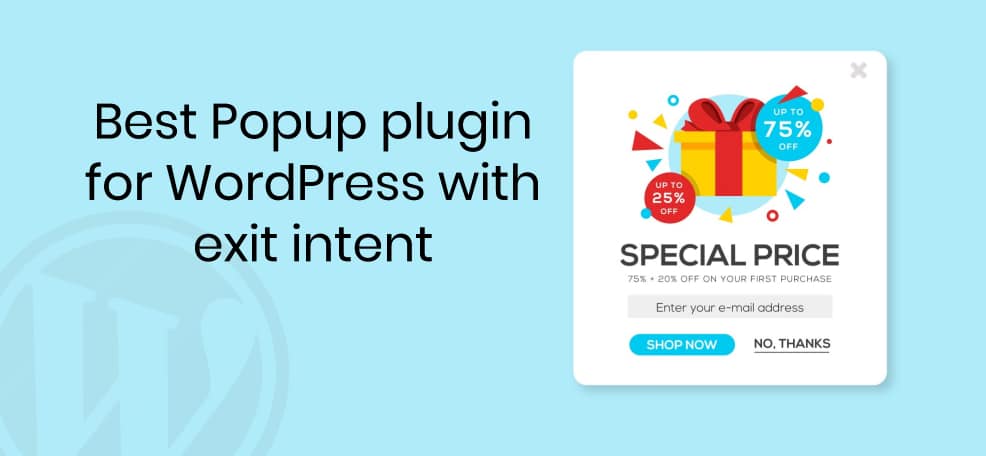If you own an online business, then chances are you’re looking to boost your conversion rates.
And if you’ve done any amount of research, then you know content is king. The only problem is there are millions of websites on the web now, and they’re all filled with content.
Sure, content is necessary to rank and attract your target audience, but it’s not guaranteed to keep them.
What keeps them is context.
That’s exactly what you need to consider in any piece of content you create — including your popups.
As you may already know, popups are an excellent tool for capturing visitors and collecting their email addresses.
But you won’t get far without building context around your campaign. For example, showing a popup offering an e-book on creating a home garden to visitors looking at your gardening product pages.
This will have a higher chance of converting than showing an offer for a guide on how to remodel a bathroom.
With the right context and the right exit-intent tools, you can build a strategy that converts.
Let’s take a look at what the best popup plugin for WordPress looks like.
Simple Popup Creation
Ever downloaded a plugin that took you hours to figure out? And even then, you still got a lot wrong?
It’s frustrating trying to learn new things, especially when you’re trying to generate results fast. This is why we recommend using a popup platform that’s designed with simplicity in mind.
For example, having a drag and drop user interface. With this setup, you’re able to create fully-functional popups within minutes. And you won’t need to know an inkling of coding language.
Of course, the platform should come with high-quality templates, so your popups look appealing. If the designs aren’t responsive (operates on any device), then this is a no-go.
And that brings us to our next point.
Comes with Responsive Popup Templates
You’re a business owner – not a coder and not a designer. So why should you spend hours trying to come up with the best look for your popups?
It’s best to use a platform that keeps everything simple. For instance, it should come with a wide range of fully-responsive templates.
This means it’ll adjust to the size of the screen of the device the visitor is on. You don’t want to run into issues with mobile visitors not being able to complete or exit out of your popup.
Poor user experience is a quick way to get visitors to leave forever.
Some of the features you want your popup platform to have include:
- Lightbox
- Full screen popups
- Top and bottom bars
- Side popups (in multiple locations)
- Mobile popups
The more features, the easier it’ll be to create a campaign that’s unique and engaging for your particular audience. It’ll also help make experimentation a breeze.
Access to Popup Campaign Data
Once you have your popups up and running, you want to keep an eye on their performance. Without stats and data, you won’t be able to tell whether a popup is performing well.
As we mentioned, experimenting is necessary because it helps improve your conversions. The popup platform you implement should come with data reports for each of your campaigns to determine which is performing better and why.
If you’re not already doing so, you should test different headlines, offers, and CTAs.
Advanced Targeting Tools
The last thing you need is to attract leads from the wrong audience. One way to ensure you don’t is to use highly-targeted popup campaigns.
This is easier to do when you’re using a platform that comes with advanced targeting tools. For example, you should be able to show popups to visitors based on the traffic source.
This will allow you to target people that come from social networks, search engines, or unique URLs. Then you should be able t to segment your popups based on time of the week or day (based on analytics reports).
It’s good to improve the user experience by limiting how many times users see the same popup (and whether they’ve already opted in). This way, they’re not annoyed by the same old popups showing up.
One way you can control this is by creating popup campaigns that target new and returning visitors separately.
Popups that Target Unique Visitor Behaviors
We discussed the importance of context and how it can help boost conversions. It’s all about reading the minds of your audience.
While this may be impossible, there are cues you can use to increase the odds of conversion. For instance, you can use exit-intent popups for users who are about to click away from your site.
Technology makes this simple to monitor. Once the mouse is moving off your window towards the X button, the popup is triggered. In this offer, you want to focus on capturing emails.
You can do this by offering a discount code in exchange for a free download of an e-book, whitepaper, or case study.
Other behaviors you can use to trigger popups are:
- Scrolling to the middle or end of a page
- Being on a page for a specific amount of time
- Clicking several times on a page
- Clicking a particular image or link
The idea is to showcase popups that relate to the behaviors of your visitors. For example, if you sell home improvement products, it wouldn’t make sense to show a popup for an e-book on how to build a home garden to someone looking at faucets.
Ability to Integrate with Email and CRM Systems
It’s great you’re using a CRM to manage customer relationships and an email campaign to maintain communication with prospects.
The problem with technology is that it becomes complicated as you add more and more tools. Yet, you need them all to be successful at what you do — growing your business.
This is why it’s imperative to use platforms that integrate with other tools to make your job easier. And it’s no different with popup platforms.
You need a tool that can integrate with relevant platforms, such as CRMs and email software. Some of the popular platforms popup platforms should integrate with include Hubspot, Zapier, MailChimp, iContact, Powerlink, and Get Response.
Ability to Experiment with A/B Split Tests
Experimentation — that word again. Can’t deny it’s importance if it comes up multiple times in one conversation!

Since it’s critical to your campaign’s success, you want a tool that will make it as easy as possible to set up these experiments. We already discussed being able to review performance reports.
But to get these, you need to create A/B tests for each of your popups. As we mentioned, it’s good to test different headlines, CTAs, and offers.
However, you only want to change one thing in each test, so you know exactly what’s causing your campaign to improve (or decline).
The popup platform you want should make it easy to set up A/B tests (say, in a minute or less). Then you should be able to compare the campaigns by triggers, interactions, timing, and patterns.
Scalability for Company Expansion
Eventually, your business is going to grow larger. And when it does, you’ll need a way to add your team members with ease.
So to make this possible, you need a popup tool that allows you to add and manage users. And then create separate accounts for each of your clients — all visible from one panel.
You should also be able to control the access level of users so they can only manage accounts they’re attached to. It sure beats sharing a single account and dealing with version control issues!
AI Tools to Optimize Your Results
There’s only but so much you can do as a human — why not enlist the help of AI? This way, you can get help with optimizing your results.
For example, Poptin offers an Autopilot Trigger that helps you pinpoint the best time of day to show your popups. It also learns visitor behavior, performs tests, and provides reports on the best and worst performers.
This is an excellent option if you don’t have time to do all of your own A/B tests.
So What’s the Best Popup Plugin for Your WordPress Site?
Well, when you look at all the features of Poptin, who can argue that it’s one of the top plugins for popups?
It comes with all the listed benefits and features. So if you’re looking to grow your business with popups, then Poptin is an excellent option.
But don’t take our word for it — sign up for the free version to get started creating your own Poptins!




